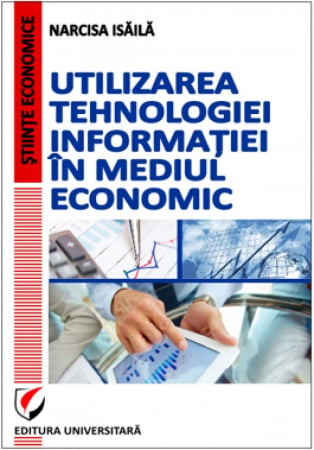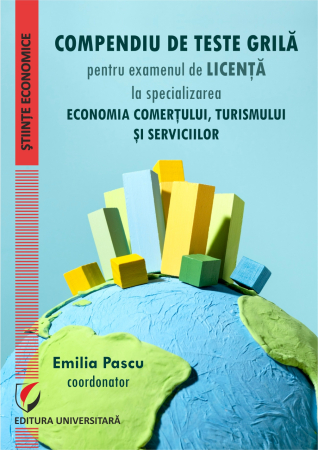Manuscript proposals: [email protected] / 0745 204 115 //// Tracking orders Individuals / Sales: 0745 200 357 / Orders Legal entities: 0721 722 783
ISBN: 978-606-28-0839-6
DOI: 10.5682/9786062808396
Publisher year: 2018
Edition: I
Pages: 198
Publisher: Editura Universitară
Author: Valentina Zaharia, Mihaela-Mirela Dogaru, Elena David, Gabriel Nastase, Cristina Stefan
Product Code:
9786062808396
Do you need help?
0745 200 357
- Description
- Download (1)
- Authors
- Content
- More details
- Reviews (0)
The interactions of an enterprise with the competitive business environment of a globalized economy produce permanent changes in the behavior of enterprises.
In this context, "Enterprise management" is a discipline of direct action to improve the economic and financial situation of enterprises.
The management of the enterprise offers the techniques and methods of practical financial action for identifying the sources of capital and their efficient allocation in order to achieve the major objective of the enterprise, which aims to increase its value, the net worth of shareholders.
Structured on the main actions of financial practice at microeconomic level, namely analysis, planning, short-term management and financial strategy, each chapter of the course presents the theoretical aspects of substantiating the indicators of business management and planning analysis.
The financial environment in which the enterprises evolve determines them to use numerous specific tools and possibilities of action, but at the same time certain constraints are conditioned on them.
The enterprises carry out their activity in a complex financial environment and in a permanent change, fact for which its own internal and external influences are also exerted on the financial management.
In this context, "Enterprise management" is a discipline of direct action to improve the economic and financial situation of enterprises.
The management of the enterprise offers the techniques and methods of practical financial action for identifying the sources of capital and their efficient allocation in order to achieve the major objective of the enterprise, which aims to increase its value, the net worth of shareholders.
Structured on the main actions of financial practice at microeconomic level, namely analysis, planning, short-term management and financial strategy, each chapter of the course presents the theoretical aspects of substantiating the indicators of business management and planning analysis.
The financial environment in which the enterprises evolve determines them to use numerous specific tools and possibilities of action, but at the same time certain constraints are conditioned on them.
The enterprises carry out their activity in a complex financial environment and in a permanent change, fact for which its own internal and external influences are also exerted on the financial management.
-
The Role of Management in the Efficient Management of the Company's Activity
Download
MIRELA-MIHAELA DOGARU
VALENTINA ZAHARIA
CRISTINA STEFAN
GABRIEL NASTASE
ELENA DAVID
VALENTINA ZAHARIA
CRISTINA STEFAN
GABRIEL NASTASE
ELENA DAVID
INTRODUCTION / 9
CHAPTER 1 - THE COMPANY AND ITS RELATIONS WITH THE ECONOMIC ENVIRONMENT / 11
1.1. Company and entrepreneurs / 11
1.1.1. The concept of company and entrepreneur / 11
1.1.2. The environment of the company / 13
1.1.3. Typology of companies / 14
1.2. Evolving company / 20
1.2.1. Company growth / 20
1.2.2. Association and regrouping of companies / 21
1.3. The enterprise network, a managerial premise in the social market economy / 24
1.3.1. Defining elements regarding the enterprise network / 24
1.3.2. Competitiveness of network enterprises / 30
1.3.3. Outsourcing as a strategy for creating business networks / 34
1.3.4. The advantages of the enterprise network / 36
1.3.5. Federalization of enterprises in order to build networks / 37
1.3.6. Organization of the enterprise network / 46
CHAPTER 2 - STRUCTURAL ORGANIZATION OF THE COMPANY AND THE DECISION-MAKING PROCESS / 49
2.1. Elements of the organizational structure / 49
2.1.1. The job / 50
2.1.2. Function / 50
2.1.3. Sphere of authority / 51
2.1.4. Work compartment / 51
2.1.5. Hierarchical channels / 52
2.1.6. Hierarchical levels / 52
2.1.7. Relations between work compartments / 54
2.2. Types of organizational structures / 56
2.2.1. Hierarchical structure / 56
2.2.2. Functional structure / 58
2.2.3. Hierarchical - functional structure (mixed) / 59
2.3. The decision-making process in the company / 60
2.3.1. Decision and its elements / 60
2.3.2. Typology of decisions / 62
CHAPTER 3. ANALYSIS OF THE FINANCIAL BALANCE OF THE ENTERPRISE / 65
3.1. Theoretical considerations / 65
3.2. Balance sheet analysis (financial balance sheet analysis) / 65
3.3. Functional balance analysis (functional balance analysis) / 67
CHAPTER 4. ANALYSIS OF THE ENTERPRISE RESULTS / 69
4.1. Theoretical considerations / 69
4.2. Intermediate management balances / 69
4.3. Self - financing capacity / 71
4.4. Profitability threshold analysis / 73
CHAPTER 5. ANALYSIS OF FINANCIAL FLOWS / 75
5.1. Theoretical considerations / 75
5.2. Financing table / 75
5.3. Cash flow statement / 76
5.4. Analysis of cash flows from the perspective of enterprise evaluation / 79
CHAPTER 6. FINANCIAL DIAGNOSIS OF PROFITABILITY AND RISK / 82
6.1. Theoretical considerations / 82
6.2 Diagnosis of profitability / 82
6.2.1 Margin rates / 82
6.2.2 Rotation rates / 83
6.2.3 Capital structure rates / 83
6.2.4. Rates of return on capital / 84
6.2. Enterprise risk diagnosis / 88
6.3.1. Economic risk / 88
6.3.2. Financial risk / 89
6.3.3. Total risk / 89
6.3.4. Risk of bankruptcy / 90
CHAPTER 7. FINANCING NEEDS OF THE ENTERPRISE ACTIVITY / 93
7.1. Theoretical considerations / 93
7.2. Turnover speeds by turnover / 93
7.3. Kinetic rate system / 94
7.4. The normative method of forecasting the financial balance / 95
CHAPTER 8. ENTERPRISE BUDGETS / 96
8.1. General considerations / 96
8.2. Production Budget / 97
8.2.1. Elaboration of the production plan / 97
8.2.2. Forecasting (pre - calculation) of production costs / 98
CHAPTER 9. TREASURY FORECASTS / 101
9.1. General considerations / 101
9.2. Treasury budget / 101
9.3. Determining the optimal level of treasury / 101
CHAPTER 10. CONTENT OF OPERATION CYCLE MANAGEMENT / 105
10.1. General considerations / 105
CHAPTER 11. OPERATING CYCLE FINANCING NEEDS / 109
11.1. General considerations / 109
11.2. Operating cycle financing requirement (NFCE) / 109
CHAPTER 12. FINANCING THE OPERATING CYCLE / 112
12.1. General considerations / 112
12.2. Own sources of financing the operating cycle / 112
12.3. Attracted sources (operating debts) / 112
12.4. Sources borrowed to finance the operating cycle / 113
12.4.1. Elements for substantiating the cost of loans / 115
12.4.2. The cost of treasury loans / 115
12.4.3. The cost of discount credits / 115
CHAPTER 13. INVESTMENT DECISIONS / 117
13.1. Theoretical considerations / 117
13.2. Decision to invest in a certain environment / 117
13.3. Decision to invest in a random environment / 119
CHAPTER 14. LONG-TERM FINANCING DECISIONS / 121
14.1. Theoretical considerations / 121
14.2. Own sources / 121
14.3. Long - term borrowed sources / 123
14.4. The cost of capital / 125
14.4.1. The cost of borrowed capital / 125
14.4.2. Cost of equity / 126
14.4.3. Weighted average cost of capital / 126
CHAPTER 15 - ANALYSIS OF THE COMPANY'S INTERNAL ENVIRONMENT / 128
15.1. Resources needed / 129
15.2. Capabilities / 131
15.3. Value chain analysis / 135
15.4. Culture of the organization / 137
15.5. The role of leadership in strategic management / 138
15.6. Internal Evaluation Matrix (IFE) / 139
CHAPTER 16 - ANALYSIS OF THE EXTERNAL ENVIRONMENT / 144
16.1. General presentation / 144
16.2. The company's macro-environment / 146
16.3. The microenvironment of the company / 154
16.4. Analysis of the macro-environment of the enterprise / 169
CHAPTER 17 - LEASING AND FRANCHISING / 174
17.1. Leasing - content and mechanism / 174
17.1.1. Content and advantages of the leasing operation / 174
17.1.2. Classification of leasing operations / 177
17.1.3. Leasing contract / 180
17.1.4. Analysis of the efficiency of the leasing operation / 183
17.1.5. Possibilities to extend the leasing in our country / 185
17.2. Franchising - assignment of the marketing right / 187
17.2.1. Content of franchising operations / 187
17.2.2. Franchise agreement / 189
17.2.3. Franchising in international trade / 193
BIBLIOGRAPHY / 195
CHAPTER 1 - THE COMPANY AND ITS RELATIONS WITH THE ECONOMIC ENVIRONMENT / 11
1.1. Company and entrepreneurs / 11
1.1.1. The concept of company and entrepreneur / 11
1.1.2. The environment of the company / 13
1.1.3. Typology of companies / 14
1.2. Evolving company / 20
1.2.1. Company growth / 20
1.2.2. Association and regrouping of companies / 21
1.3. The enterprise network, a managerial premise in the social market economy / 24
1.3.1. Defining elements regarding the enterprise network / 24
1.3.2. Competitiveness of network enterprises / 30
1.3.3. Outsourcing as a strategy for creating business networks / 34
1.3.4. The advantages of the enterprise network / 36
1.3.5. Federalization of enterprises in order to build networks / 37
1.3.6. Organization of the enterprise network / 46
CHAPTER 2 - STRUCTURAL ORGANIZATION OF THE COMPANY AND THE DECISION-MAKING PROCESS / 49
2.1. Elements of the organizational structure / 49
2.1.1. The job / 50
2.1.2. Function / 50
2.1.3. Sphere of authority / 51
2.1.4. Work compartment / 51
2.1.5. Hierarchical channels / 52
2.1.6. Hierarchical levels / 52
2.1.7. Relations between work compartments / 54
2.2. Types of organizational structures / 56
2.2.1. Hierarchical structure / 56
2.2.2. Functional structure / 58
2.2.3. Hierarchical - functional structure (mixed) / 59
2.3. The decision-making process in the company / 60
2.3.1. Decision and its elements / 60
2.3.2. Typology of decisions / 62
CHAPTER 3. ANALYSIS OF THE FINANCIAL BALANCE OF THE ENTERPRISE / 65
3.1. Theoretical considerations / 65
3.2. Balance sheet analysis (financial balance sheet analysis) / 65
3.3. Functional balance analysis (functional balance analysis) / 67
CHAPTER 4. ANALYSIS OF THE ENTERPRISE RESULTS / 69
4.1. Theoretical considerations / 69
4.2. Intermediate management balances / 69
4.3. Self - financing capacity / 71
4.4. Profitability threshold analysis / 73
CHAPTER 5. ANALYSIS OF FINANCIAL FLOWS / 75
5.1. Theoretical considerations / 75
5.2. Financing table / 75
5.3. Cash flow statement / 76
5.4. Analysis of cash flows from the perspective of enterprise evaluation / 79
CHAPTER 6. FINANCIAL DIAGNOSIS OF PROFITABILITY AND RISK / 82
6.1. Theoretical considerations / 82
6.2 Diagnosis of profitability / 82
6.2.1 Margin rates / 82
6.2.2 Rotation rates / 83
6.2.3 Capital structure rates / 83
6.2.4. Rates of return on capital / 84
6.2. Enterprise risk diagnosis / 88
6.3.1. Economic risk / 88
6.3.2. Financial risk / 89
6.3.3. Total risk / 89
6.3.4. Risk of bankruptcy / 90
CHAPTER 7. FINANCING NEEDS OF THE ENTERPRISE ACTIVITY / 93
7.1. Theoretical considerations / 93
7.2. Turnover speeds by turnover / 93
7.3. Kinetic rate system / 94
7.4. The normative method of forecasting the financial balance / 95
CHAPTER 8. ENTERPRISE BUDGETS / 96
8.1. General considerations / 96
8.2. Production Budget / 97
8.2.1. Elaboration of the production plan / 97
8.2.2. Forecasting (pre - calculation) of production costs / 98
CHAPTER 9. TREASURY FORECASTS / 101
9.1. General considerations / 101
9.2. Treasury budget / 101
9.3. Determining the optimal level of treasury / 101
CHAPTER 10. CONTENT OF OPERATION CYCLE MANAGEMENT / 105
10.1. General considerations / 105
CHAPTER 11. OPERATING CYCLE FINANCING NEEDS / 109
11.1. General considerations / 109
11.2. Operating cycle financing requirement (NFCE) / 109
CHAPTER 12. FINANCING THE OPERATING CYCLE / 112
12.1. General considerations / 112
12.2. Own sources of financing the operating cycle / 112
12.3. Attracted sources (operating debts) / 112
12.4. Sources borrowed to finance the operating cycle / 113
12.4.1. Elements for substantiating the cost of loans / 115
12.4.2. The cost of treasury loans / 115
12.4.3. The cost of discount credits / 115
CHAPTER 13. INVESTMENT DECISIONS / 117
13.1. Theoretical considerations / 117
13.2. Decision to invest in a certain environment / 117
13.3. Decision to invest in a random environment / 119
CHAPTER 14. LONG-TERM FINANCING DECISIONS / 121
14.1. Theoretical considerations / 121
14.2. Own sources / 121
14.3. Long - term borrowed sources / 123
14.4. The cost of capital / 125
14.4.1. The cost of borrowed capital / 125
14.4.2. Cost of equity / 126
14.4.3. Weighted average cost of capital / 126
CHAPTER 15 - ANALYSIS OF THE COMPANY'S INTERNAL ENVIRONMENT / 128
15.1. Resources needed / 129
15.2. Capabilities / 131
15.3. Value chain analysis / 135
15.4. Culture of the organization / 137
15.5. The role of leadership in strategic management / 138
15.6. Internal Evaluation Matrix (IFE) / 139
CHAPTER 16 - ANALYSIS OF THE EXTERNAL ENVIRONMENT / 144
16.1. General presentation / 144
16.2. The company's macro-environment / 146
16.3. The microenvironment of the company / 154
16.4. Analysis of the macro-environment of the enterprise / 169
CHAPTER 17 - LEASING AND FRANCHISING / 174
17.1. Leasing - content and mechanism / 174
17.1.1. Content and advantages of the leasing operation / 174
17.1.2. Classification of leasing operations / 177
17.1.3. Leasing contract / 180
17.1.4. Analysis of the efficiency of the leasing operation / 183
17.1.5. Possibilities to extend the leasing in our country / 185
17.2. Franchising - assignment of the marketing right / 187
17.2.1. Content of franchising operations / 187
17.2.2. Franchise agreement / 189
17.2.3. Franchising in international trade / 193
BIBLIOGRAPHY / 195
The interactions of an enterprise with the competitive business environment of a globalized economy produce permanent changes in the behavior of enterprises.
In this context, "Enterprise management" is a discipline of direct action to improve the economic and financial situation of enterprises.
The management of the enterprise offers the techniques and methods of practical financial action for identifying the sources of capital and their efficient allocation in order to achieve the major objective of the enterprise, which aims to increase its value, the net worth of shareholders.
Structured on the main actions of financial practice at microeconomic level, namely analysis, planning, short-term management and financial strategy, each chapter of the course presents the theoretical aspects of substantiating the indicators of business management and planning analysis.
The financial environment in which the enterprises evolve determines them to use numerous specific tools and possibilities of action, but at the same time certain constraints are conditioned on them.
The enterprises carry out their activity in a complex financial environment and in a permanent change, fact for which its own internal and external influences are also exerted on the financial management.
In this context, "Enterprise management" is a discipline of direct action to improve the economic and financial situation of enterprises.
The management of the enterprise offers the techniques and methods of practical financial action for identifying the sources of capital and their efficient allocation in order to achieve the major objective of the enterprise, which aims to increase its value, the net worth of shareholders.
Structured on the main actions of financial practice at microeconomic level, namely analysis, planning, short-term management and financial strategy, each chapter of the course presents the theoretical aspects of substantiating the indicators of business management and planning analysis.
The financial environment in which the enterprises evolve determines them to use numerous specific tools and possibilities of action, but at the same time certain constraints are conditioned on them.
The enterprises carry out their activity in a complex financial environment and in a permanent change, fact for which its own internal and external influences are also exerted on the financial management.
If you want to express your opinion about this product you can add a review.
write a review

6359.png)
![The Role of Management in the Efficient Management of the Company's Activity [1] The Role of Management in the Efficient Management of the Company's Activity [1]](https://gomagcdn.ro/domains/editurauniversitara.ro/files/product/large/rolul-managementului-in-gestionarea-eficienta-a-activitatii-firmei-223-836717.jpg)














